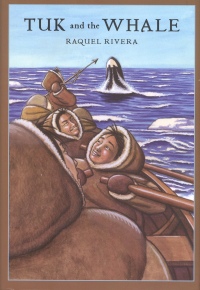| ________________
CM . . .
. Volume XIV Number 21. . . .June 13, 2008
excerpt:
Tuk and the people in his camp cautiously welcome strangers, or Qallunaat, who arrive on the biggest boat anyone has ever seen. Tuk's grandfather has predicted their arrival, and he advises that his people help them because, if they do so, the strangers will leave in peace. And what do these people want? Whale. Together the strangers and the men in Tuk's camp venture out onto the ocean to hunt the prized arvik, or bowhead whale. This short chapter book gives readers an interesting, and what might be an accurate, glimpse into the day-to-day life of the Inuit living in a winter camp on Baffin Island in the early 1600s. It is refreshing to read from the First Nations' perspectives about their first encounters with Europeans. By taking their viewpoint, readers are able to understand how strange and disconcerting it was to meet these strangers. Riveria really did her homework as attested by the list of sources she used and by her willingness to seek experts' help in the development of this book as explained in an Author's Note near the end of the book. The realistic looking black and white illustrations bring to life the desolateness of where the camp is situated. One particular picture captures the excitement and danger of the whale hunt. The slow pace helps to build the suspense and slight tension between Tuk's people and the European whalers. While reading this story, readers cannot help but think about some questions: Can the strangers be trusted? Can they and Tuk's people work together to hunt for whale despite the language and cultural differences? Highly Recommended. Min So is an on-call children's librarian at Vancouver Public Library.
To comment
on this title or this review, send mail to cm@umanitoba.ca.
Copyright © the Manitoba Library Association. Reproduction for personal
use is permitted only if this copyright notice is maintained. Any
other reproduction is prohibited without permission.
NEXT REVIEW |
TABLE OF CONTENTS FOR THIS ISSUE
- June 13, 2008.
AUTHORS |
TITLES |
MEDIA REVIEWS |
PROFILES |
BACK ISSUES |
SEARCH |
CMARCHIVE |
HOME |
